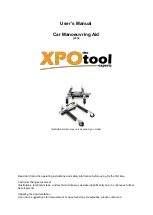
10 | AXYGEN AXYPET PIPETTORS
5. Dense and Viscous Liquids
The pipettor’s specifications of accuracy and precision are
based on pipetting distilled water. Handling of liquids with
physical qualities of density, viscosity, and surface tension
which differ substantially from water may need to be
gravimetrically checked for compensation of the volume
setting. Normally the degree of error resulting from heavy
or viscous liquids is negligible if pipetting is done slowly
and carefully. It is most important to give the liquids
some time to react to the change of pressure by holding
the pipet tip in its position for at least 2 seconds after the
aspiration and the blow out stroke.
If in extreme cases, this method of operation does not
result in accurate values, compensation may be achieved
as follows:
• Weigh the pipetted liquid when the pipettor is set to
the nominal value. Then calculate the set-off from the
nominal value:
Correction, value = 2 x nominal val. —
m = weight of the sample
γ
= density of liquid
• Check this operation once again and correct if necessary.
Note the corrected value for further pipetting of the
same kind of liquid.
6. Axygen® Pipet Tips
Axygen pipet tips are made from high performance
polypropylene and their quality ensures the precision
and accuracy associated with the pipettor. Strict control
is maintained throughout the manufacturing process to
ensure the highest quality.
The accuracy and precision figures for the pipettors are
only guaranteed when Axygen pipet tips are used. The
use of inferior quality tips will seriously degrade the
performance of the pipettor.
Refer to Pages 4 and 5 for information on proper pipet tips
sizes, accuracy, and precision values.
7. Recommendations
Observing the following recommendations will ensure
maximum possible accuracy and precision of liquid sampling.
• Make sure to operate the pipettor slowly and smoothly.
• The depth of immersion in the sample liquid should be
the minimum necessary and should remain constant
during aspiration.
γ
m










































